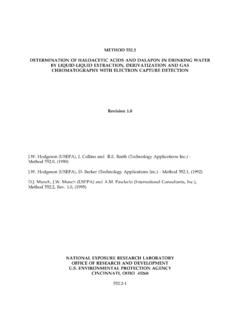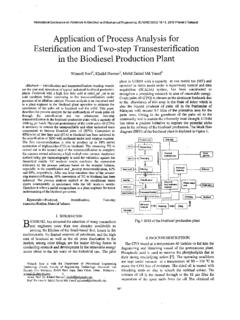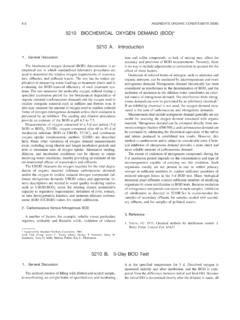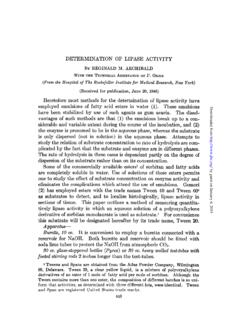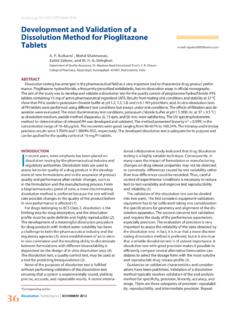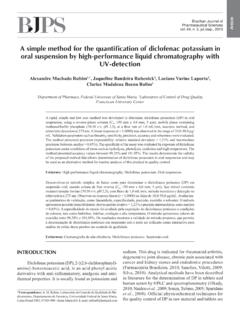Transcription of Comparison of methodologies for moisture …
1 ISSN 0101-2061Ci ncia e Tecnologia de AlimentosRecebido para publica o em 13/4/2009 Aceito para publica o em 25/9/2009 (004159)1 Food Department, Pharmaceutical Science School, University of Sao Paulo USP, Av. Prof. Lineu Prestes, 580, Bloco 14, CEP 05508-900, S o Paulo - SP, Brasil, E-mails: quem a correspond ncia deve ser enviadaComparison of methodologies for moisture determination on dried bee pollen samplesCompara o de metodologias para determina o de umidade em amostras de p len ap cola desidratadasIllana Louise Pereira de MELO1, Ligia Bicudo de ALMEIDA-MURADIAN1*1 Introduction Pollen grains are microscopic structures found in the anthers of stamens in angiosperms and represent the male gametophyte of flowers.
2 Besides being the very object of pollination, for many insects and especially to bees, pollen is the main source of food, essential for normal growth and development of all individuals of a colony of bees and to the reproduction of colonies (KRELL, 1996; ALMEIDA-MURADIAN et al., 2007; CAMPOS et al., 2008). Pollen is very important in apiculture as a natural source of proteins, fats, minerals and vitamins to bees and as a product surplus from apiary (WITHERELL, 1975; HERBERT JR.; SHIMANUKI, 1978; VILLANUEVA et al.)
3 , 2002). According to the Normative Instruction N 3 from the Brazilian regulation, January 19, 2001 (BRASIL, 2001), bee pollen is the result of the agglutination of flower pollens, carried out by worker honey bees, with nectar (and/or honey) and salivary substances, and collected at the hive entrance. This definition has also been reported by Campos et al. (2008) when an international technical regulation for identity and quality of bee pollen standard was concern of consumers in developed countries with food quality and, consequently, the reduction of risks to health, is growing.
4 In this sense, bee pollen has prominence in human nutrition as a food differential due to its nutritious and medicinal properties and also because of its high protein content (VILLANUEVA et al., 2002; MARCHINI; REIS; MORETI, 2006).According to the technical regulations proposed by Campos et al. (2008), bee pollen can be classified according to its moisture content for commercialization purposes. Bee pollen is the product collected in the original form, with water content between 20-30%, and dried bee pollen is the product submitted to a drying process at temperatures not higher than 42 C, with water content not higher than 6%.
5 Because bee pollen displays high moisture content in its composition, which causes fermentation and rapid deterioration (HERBERT JR.; SHIMANUKI, 1978; CORNEJO, 1994), a drying out process is essential. moisture content is used for biological control in storage and commercialization of the product, since water content affects via water activity enzymatic and microbiological stability and, thus, shelf life of food (SILVA et al., 2001; ISENGARD; KLING; REH, 2006). Some countries have established official quality and identity standards of bee pollen such as: Argentina (C DIGO ALIMENTARIO Argentino de p len, Art culo 785 Resolucion 1550 de 12/12/1990), Brazil (BRASIL, 2001), Bulgaria ResumoO teor de umidade do p len ap cola constitui um par metro de qualidade para este produto.
6 Alguns pa ses como Argentina, Brasil, Bulg ria, Pol nia e Su a t m legisla o espec fica quanto aos par metros de qualidade do p len ap cola, mas n o s o claras quanto recomenda o do m todo a ser utilizado na determina o de umidade. O objetivo deste trabalho foi comparar seis m todos de determina o de umidade do p len ap cola desidratado. Os m todos utilizados foram: estufa convencional a 100 C, estufa a v cuo a 70 C, dessecador com cido sulf rico, secagem por radia o infravermelha, liofiliza o e Karl Fisher. De acordo com os resultados obtidos, os melhores m todos para determina o de umidade do p len ap cola foram a secagem por radia o infravermelha e a liofiliza o, os quais apresentaram menores valores de : p len ap cola; umidade; m pollen moisture value is one of the quality parameters for this product.
7 Some countries such as Argentina, Brazil, Bulgaria, Poland and Switzerland have bee pollen regulations on quality parameters, but these are not clear regarding which method should be used for moisture determination. The aim of this paper was to compare six methods of moisture determination in dried bee pollen samples. The methods were: conventional oven at 100 C, vacuum oven at 70 C, desiccator with sulfuric acid, drying out process with infrared light at 85 C, lyophilization and Karl Fisher s method. Based on the results, the best methods for moisture determination of bee pollen were the drying process with infrared and the lyophilization, since these have shown lower moisture : bee pollen; moisture ; nc.
8 Tecnol. Aliment., Campinas, 31(1): 194-197, 2011194 OriginalMelo; Almeida-MuradianVI Karl Fischer s method, using the apparatus of Mettler Toledo (DL38) based on the amount of reagent of Karl Fischer (with its correction factor) required to hold the water in the rate of the sample methods described in items I, II, III, IV and VI followed the procedure described by Serra-Bonvehi and Casanova (1987). The methods I, II and III are also listed by AOAC ( , 1995). The process of lyophilization was based on the work of Liapis, Millman and Marchello (1985) and Boss (2004).
9 In all cases, samples were ground to better homogenization of the batches and a rate of each of the samples (approximately 2 g, except method IV which used approximately 1 g) was submitted to the process. All batches were analyzed in triplicate, except for the Karl Fischer s, which was made in two content of samples submitted to processes I, II, III and V up to constant weight was calculated using the Equation 1:()()'%100100mtmoisturemt = (1)where:m = total mass of the system (glass + sample) at the beginning of the process;m = total mass of the system (glass + sample) at the end of the process.
10 T = mass of glass the analysis that used infrared radiation, a rate of the sample was applied to a holder (small aluminum plate) previously weighed, according to Cornejo (1994) and Oliveira (2006). After that, radiation was reflected on the sample and the percentage of moisture was displayed on the equipment. The determination of moisture by the volumetric method was based on aquametria with reagent Karl Fischer . The moisture content was estimated based on the amount of reagent (with its correction factor) required to hold the water in the rate of the sample tested.











